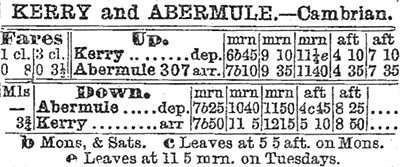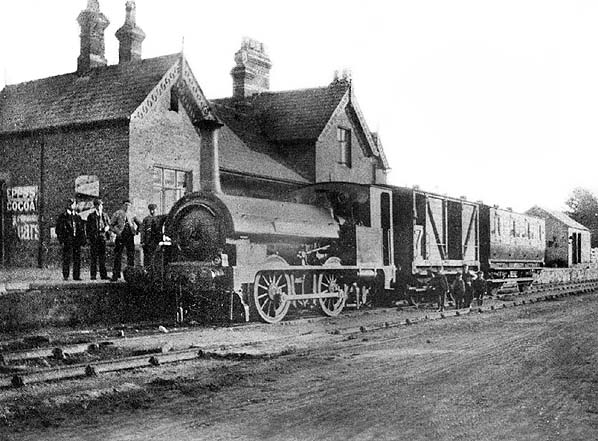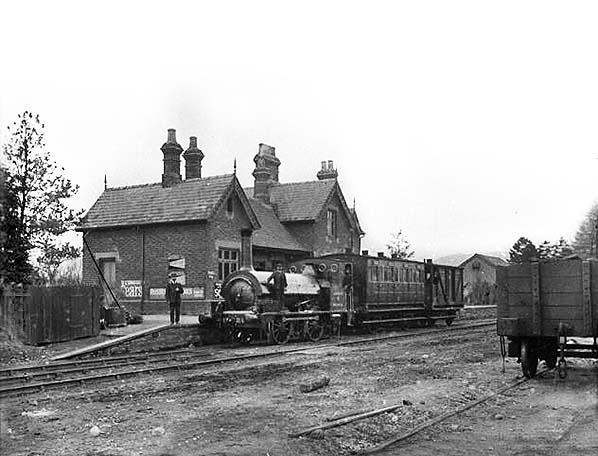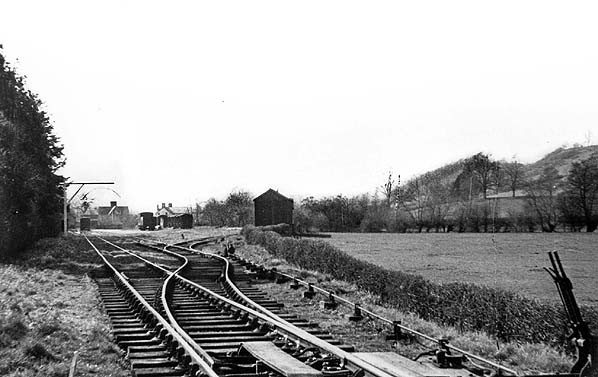Notes: Kerry was the southern terminus of the 3¾ mile Kerry Branch railway which was opened by the Oswestry & Newtown Railway (O&NR) on 2 March 1863. The branch connected to the O&NR main line at Abermule. John Wilkes Poundley had been building up a trade in what became the famous Kerry breed of sheep and he sought a rail link to Kerry so that he could expand his business. The branch was authorised on 17 May 1861. Passenger services began first with goods trains following on 1 July 1863.
 |
Kerry station was actually located in Glanmule a mile to the east of the village of Kerry. It was within the fork of the Kerry and Sarn road (the A489) and the Abermule road (B4368) to the west of the Afon Miwl. The branch was single track and the station had only a single platform located on the south side of the line. It was provided with an attractive cottage ornée building consisting of a two-storey station house and contiguous single-storey office range. The gables were adorned with pierced bargeboards.
At the west end of the platform there was a turntable.
The station also had goods facilities located on the north side of the branch which included two sidings, a goods shed and a loading ramp. There was also an engine shed on east side of the site.
 At the time of opening the trains between Kerry and Abermule were worked by Sharp Stewart 0-4-0 Saddle Tank locomotives No.36 Plasfnnon, No.37 Mountaineer and No.38 Prometheus, all of which were shedded at Kerry. The trains became affectionately known as The Kerry Express and usually consisted of a 1st/3rd class coach, which had ‘Kerry Branch’ emblazoned on the side, and some wagons. It took 25 minutes to complete a journey between Kerry and Abermule. At the time of opening the trains between Kerry and Abermule were worked by Sharp Stewart 0-4-0 Saddle Tank locomotives No.36 Plasfnnon, No.37 Mountaineer and No.38 Prometheus, all of which were shedded at Kerry. The trains became affectionately known as The Kerry Express and usually consisted of a 1st/3rd class coach, which had ‘Kerry Branch’ emblazoned on the side, and some wagons. It took 25 minutes to complete a journey between Kerry and Abermule.
On 25 July 1864 the O&NR joined with a number of other companies to form the Cambrian Railway (CR).
In 1887 a 2ft gauge tramway was opened between Kerry station and the Brynllywarch estate which was owned by Christopher Naylor. The line served the timber forests on the estate, as well as a slab quarry; it also handled general estate traffic. Transhipment facilities were developed at Kerry station so that materials could be easily transferred between the tramway and the railway. The tramway closed in 1895 and it was lifted shortly after.
 The December 1895 timetable showed four departures and arrivals on Tuesday-to-Friday. On Monday (Welshpool Market Day) and Saturday there was an extra train in each direction. The December 1895 timetable showed four departures and arrivals on Tuesday-to-Friday. On Monday (Welshpool Market Day) and Saturday there was an extra train in each direction.
By 1903 the station had gained a weighing machine, a crane and an additional goods shed.
By 1907 the three Sharp Stewart locomotives of 1863 vintage had been withdrawn and the line was generally worked by one locomotive.
During the First World War there was a great demand for timber. In 1917 the government Timber Supply Department (which later became the Forestry Commission) re-laid much of the tramway to serve a saw mill on the Brynllywarch estate. The tramway and timber-felling operations were mainly manned by German prisoners of war under military control. During the war, the line was worked by the Kerr Stuart locomotive Diana. After hostilities ceased the tramway continued to operate.
Due to coal shortages an emergency timetable was introduced on 5 May 1921 which reduced the service to Tuesdays only.
On 1 January 1922 Kerry station became part of the Great Western Railway (GWR). The July 1922 timetable showed one departure on Monday, Thursday and Friday. There were two trains to Abermule on Tuesday, Wednesday and Saturday. There was only one arrival from Abermule on Monday, Tuesday, Thursday and Friday. On Wednesday and Saturday there were two trains from Abermule. There were no trains on Sunday.
 On 9 July 1923 the GWR opened halts on the branch at Ffronfraith and Goitre. They operated the line using former CR 0-6-0 and 2-4-0 tank engines. On 9 July 1923 the GWR opened halts on the branch at Ffronfraith and Goitre. They operated the line using former CR 0-6-0 and 2-4-0 tank engines.
The Kerry tramway closed in 1925 (sections of it having already gone out of use in 1922) and once again the track was lifted.
By 1930 there were only a few passenger trains in each direction on Monday-to-Saturday which led to the GWR withdrawing the service completely on 9 February 1931.
Sunday school excursion trains continued to run until 1939.
Goods services continued to operate on the branch which became part of British Railways [Western Region] (BR[WR]) on 1 January 1948. Goods services were withdrawn on 1 May 1956 and the track was lifted by the end of 1959. In 2016 the station building was in use as a private residence. a goods office and the engine shed were also still standing.
Ticket from Michael Stewart and route map by Alan Young
Sources:
- A Regional History of the Railways of Great Britain - Volume II North & Mid Wales - Peter E Baughan - David & Charles 1980.
- Encyclopaedia of British Railway Companies - Christopher Awdry - Guild Publishing 1990.
- Railway Passenger Stations in Great Britain - A Chronology - Michael Quick - Railway & Canal Historical Society 2009.
To see other stations on the Kerry - Abermule line click on the station name: Goitre Halt, Ffronfraith Halt and Abermule |












 At the time of opening the trains between Kerry and Abermule were worked by Sharp Stewart 0-4-0 Saddle Tank locomotives No.36 Plasfnnon, No.37 Mountaineer and No.38 Prometheus, all of which were shedded at Kerry. The trains became affectionately known as The Kerry Express and usually consisted of a 1st/3rd class coach, which had ‘Kerry Branch’ emblazoned on the side, and some wagons. It took 25 minutes to complete a journey between Kerry and Abermule.
At the time of opening the trains between Kerry and Abermule were worked by Sharp Stewart 0-4-0 Saddle Tank locomotives No.36 Plasfnnon, No.37 Mountaineer and No.38 Prometheus, all of which were shedded at Kerry. The trains became affectionately known as The Kerry Express and usually consisted of a 1st/3rd class coach, which had ‘Kerry Branch’ emblazoned on the side, and some wagons. It took 25 minutes to complete a journey between Kerry and Abermule.  The December 1895 timetable showed four departures and arrivals on Tuesday-to-Friday. On Monday (Welshpool Market Day) and Saturday there was an extra train in each direction.
The December 1895 timetable showed four departures and arrivals on Tuesday-to-Friday. On Monday (Welshpool Market Day) and Saturday there was an extra train in each direction.  On 9 July 1923 the GWR opened halts on the branch at Ffronfraith and Goitre. They operated the line using former CR 0-6-0 and 2-4-0 tank engines.
On 9 July 1923 the GWR opened halts on the branch at Ffronfraith and Goitre. They operated the line using former CR 0-6-0 and 2-4-0 tank engines. .jpg)
.jpg)

 Home Page
Home Page